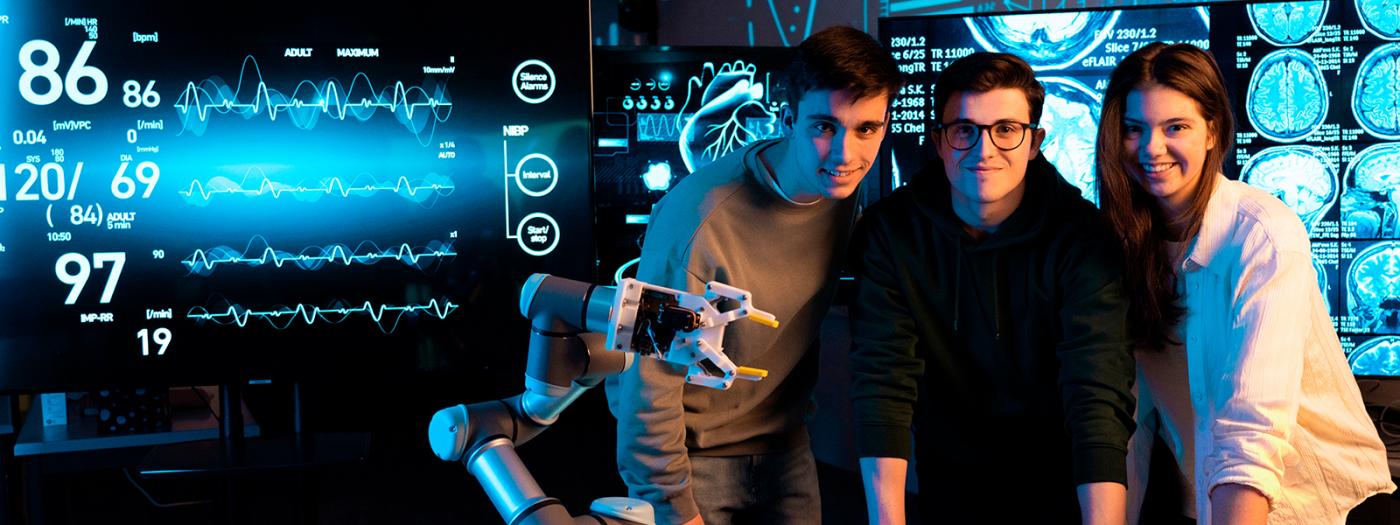To successfully complete this course, a strong command of Mathematics is crucial. This includes algebra, calculus, and, fundamentally, linear algebra, as this knowledge forms the basis for spatial representation and orientation. A background in Physics is also required for the analysis of motion (kinematics) and forces (dynamics) that govern robotic control.
From an Engineering perspective, it will be useful for students to have prior knowledge in mechanical design to understand physical components, kinematic chains, and degrees of freedom (DoF). In the field of electrical and electronic engineering, an understanding of control systems and the integration of sensors (e.g., encoders for joint position) and actuators (e.g., servomotors) is necessary. Finally, a foundation in Computer Science and programming is needed for the development of the course's practical assignments.
Finally, familiarity with the medical context is highly beneficial, especially with the principles of Minimally Invasive Surgery (MIS), which are the main application of robotic systems in healthcare.
The objectives of the Medical Robotics course are as follows:
? To acquire basic general knowledge about robotics.
? To gain knowledge about the most widely used robotic platforms on the market.
? To learn about the use of techniques and new software tools for designing robotic systems.
Module 1. Introduction to Robotics
1. Introduction
2. Definition of a Robot
3. Robotics as a Multidisciplinary Field
4. History of Robotics
Module 2. Types of Robots
1. Robot Classification
2. Industrial Robotics
3. Mobile Robotics
4. Other Types
Module 3. Robotic Systems Design
1. Mathematical Representation of Space
2. Kinematic Chain
3. Typical Robot Configurations
4. Example: Universal Robots UR3e
5. Appendix: Quaternions
6. Appendix: Transformation Matrices
Module 4. Robotic Control
1. Kinematics
2. Dynamics: Forces and Torques
3. Trajectory Planning
Module 5. Robotic Sensors and Actuators
1. Introduction
2. Sensors
3. Actuators
4. End Effector
5. Transmission and Reduction Gear
Module 6. Robotics for Health and Assistance Applications
1. Introduction
2. History
3. Classification of Medical Robots
4. Levels of Autonomy in Surgical Robotics
5. Future Research
6. Appendix: Ethical, Legal, and Social Implications (ELSI)
The methodology used in the Medical Robotics course combines lectures with a series of seminars co-taught by professionals in the field of medical robotics, as well as a number of continuous assessment practical assignments that the student must solve with the help of peers and the course teaching team. The theoretical content acquired in in-person classes is reinforced through the completion of group practicals, which are submitted throughout the course.
This course uses a virtual platform as a means of communication between the student and the professor. On this platform, the materials needed throughout the course will be published (theoretical content, tool user manuals, practical session statements, support content, etc.).
The course is assessed through two main blocks. The first is Theory, evaluated via a Final Exam, which is mandatory to attend. This exam will consist of multiple-choice questions covering the entire course syllabus and the knowledge acquired in the practicals. The second block is the Practicals, which consist of 5 assignments (P1-P5) applied to physical robots. The assessment of these practicals is conducted through personal interviews and a live demonstration of their code functioning on the robot.
The final grade is composed of 50% from the Theory grade and 50% from the Practicals grade. The Theory grade is the score obtained on the Final Exam. The Practicals grade is calculated as the arithmetic average of the 5 submitted practicals. To pass the course, the final grade must be 5 or higher. Students who do not pass the final exam will have a resit opportunity. It is important to note that grades, for both theory and practicals, are not carried over from one academic year to the next.
Considine, D. M., & Considine, G. D. (2012). Standard Handbook of Industrial Automation.
Kebria, P. M., Al-wais, S., Abdi, H., & Nahavandi, S. (2016). Kinematic and dynamic modelling of UR5 manipulator. 2016 IEEE International Conference on Systems, Man, and Cybernetics (SMC), 004229?004234. doi:10.1109/SMC.2016.7844896
Coordinates and Transformations. (n.d.). Retrieved from https://motion.cs.illinois.edu/RoboticSystems/CoordinateTransformations....
Spong, M. W., Hutchinson, S., & Vidyasagar, M. (2005). Robot Modeling and Control. Retrieved from https://books.google.es/books?id=muCMAAAACAAJ
How Do Robot Manipulators Move? (n.d.). Retrieved 17 February 2025, from https://roboticseabass.com/2024/06/30/how-do-robot-manipulators-move/
Lynch, K. M., & Park, F. C. (2017). Modern Robotics: Mechanics, Planning, and Control (1st ed.). USA: Cambridge University Press.
Dupont, P. E., Nelson, B. J., Goldfarb, M., Hannaford, B., Menciassi, A., O?Malley, M. K., ? Yang, G.-Z. (2021). A decade retrospective of medical robotics research from 2010 to 2020. Science Robotics, 6(60), eabi8017. doi:10.1126/scirobotics.abi8017
Reddy, K., Gharde, P., Tayade, H., Patil, M., Reddy, L. S., & Surya, D. (2023). Advancements in Robotic Surgery: A Comprehensive Overview of Current Utilizations and Upcoming Frontiers. Cureus, 15(12), e50415.
Yip, M., Salcudean, S., Goldberg, K., Althoefer, K., Menciassi, A., Opfermann, J. D., ? Lee, I.-C. (2023). Artificial intelligence meets medical robotics. Science, 381(6654), 141?146. doi:10.1126/science.adj3312
Attanasio, A., Scaglioni, B., De Momi, E., Fiorini, P., & Valdastri, P. (2021). Autonomy in Surgical Robotics. Annual Review of Control, Robotics, and Autonomous Systems, 4(Volume 4, 2021), 651?679. doi:10.1146/annurev-control-062420-090543
Cruz, E. M. G. N. V., Oliveira, S., & Correia, A. (2024). Robotics Applications in the Hospital Domain: A Literature Review. Applied System Innovation, 7(6). doi:10.3390/asi7060125
Matari?, M. J., & Scassellati, B. (2016). Socially assistive robotics. Springer Handbook of Robotics, 1973?1994.
Yang, G.-Z., Cambias, J., Cleary, K., Daimler, E., Drake, J., Dupont, P. E., ? Taylor, R. H. (2017). Medical robotics-Regulatory, ethical, and legal considerations for increasing levels of autonomy. Sci Robot, 2(4).
Shah, J., Vyas, A., & Vyas, D. (2014). The History of Robotics in Surgical Specialties. Am J Robot Surg, 1(1), 12?20.
Pugin, F., Bucher, P., & Morel, P. (2011). History of robotic surgery: From AESOP® and ZEUS® to da Vinci®. Journal of Visceral Surgery, 148(5, Supplement), 3?8. doi:10.1016/j.jviscsurg.2011.04.007
Universal Robots Academy (https://academy.universal-robots.com/)
